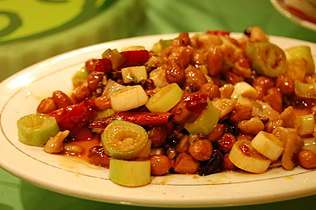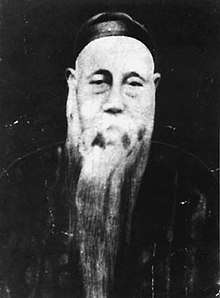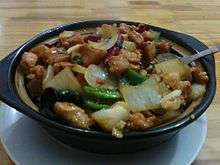Kung Pao chicken
Kung Pao chicken (Chinese: 宫保鸡丁; pinyin: Gōngbǎo jīdīng), also transcribed Gong Bao or Kung Po, is a spicy, stir-fried Chinese dish made with cubes of chicken, peanuts, vegetables (traditionally Welsh onion only), and chili peppers. The classic dish in Sichuan cuisine originated in the Sichuan Province of south-western China and includes Sichuan peppercorns. Although the dish is found throughout China, there are regional variations that are typically less spicy than the Sichuan serving. Kung Pao chicken is also a staple of Westernized Chinese cuisine.
 A Sichuan version of Kung Pao chicken | |
| Type | Stir-fry |
|---|---|
| Course | Main |
| Place of origin | China |
| Region or state | Sichuan |
| Associated national cuisine | Sichuan cuisine |
| Invented | Mid-to-late 19th century |
| Serving temperature | Hot |
| Main ingredients | Cubed boneless chicken, chili peppers, peanuts |
| Variations | Guizhou, Anhui, American |
| Kung Pao chicken | |||||||||||||||||
|---|---|---|---|---|---|---|---|---|---|---|---|---|---|---|---|---|---|
| Traditional Chinese | 宮保雞丁 | ||||||||||||||||
| Simplified Chinese | 宫保鸡丁 | ||||||||||||||||
| Literal meaning | Palace Guardian chicken cubes | ||||||||||||||||
| |||||||||||||||||
History


The dish is believed to be named after Ding Baozhen (1820–1886), a late Qing Dynasty official and governor of Sichuan Province. His title was Taizi Shaobao, which is one of Gongbao (Chinese: 宫保; pinyin: Gōngbǎo; Wade–Giles: Kung1-pao3; lit.: 'Palace Guardian').[1] The name Kung Pao chicken is derived from this title, while the use of the character 丁 dīng in the name of the dish is a pun on his surname Dīng, a moderately common Chinese surname that can also be read to mean "small cube" (like the cubes the chicken is diced into for the dish).
During the Cultural Revolution, the dish's name became politically incorrect because of its association with the imperial system. The dish was renamed "spicy chicken" (Chinese: 糊辣鸡丁; pinyin: húlà jīdīng) by Maoists until its political rehabilitation in the 1980s under Deng Xiaoping's reforms.[2]
Versions
Sichuan version
The original Sichuan version uses chicken as its primary ingredient. In this original version, diced chicken is typically mixed with a prepared marinade.[3] Shaoxing wine is used to enhance flavor in the marinade. The wok is seasoned and then chili peppers and Sichuan peppercorns are flash-fried to add fragrance to the oil. In Sichuan, or when preparing Sichuan-style Kung Pao chicken, only Sichuan-style chili peppers such as facing heaven pepper or seven stars pepper (Chinese: 七星椒; pinyin: qīxīngjiāo) are used. Smaller, thinner Sichuanese varieties may also be used.[4] Sichuan peppercorns are then added; while Kung Pao chicken does not belong to the numbing-spicy "mala" flavor profile (Chinese: 麻辣味型; pinyin: málà wèixíng), a small amount of fresh toasted peppercorns are traditionally used to balance the heat of the chilis.[5] Then the chicken is stir-fried and chopped leeks, along with peanuts, are added. Kung Pao chicken starts off with fresh, moist, unroasted peanuts.[6] These are often used instead of their pre-roasted versions. The peanuts are dropped into the hot oil at the bottom of the wok, then deep-fried until golden brown before the other ingredients are added.
Variants exist that use other meats in place of chicken, such as "Kung Pao shrimp" (Chinese: 宫保虾) [7] and "Kung Pao frog legs" (Chinese: 宫保田鸡).[8]
Guizhou version
The neighboring province of Guizhou, southeast of Sichuan, has a variant of Kung Pao chicken based on the ciba fermented chili paste (Chinese: 糍粑辣椒 cíbā làjiāo) of Guizhou cuisine. Like the Sichuan version, the dish features marinated cubes of chicken; while the Guizhou marinade is largely the same as the Sichuan version's, the chicken cubes are larger and typically skin-on. The dish is further distinguished in that rather than flash-frying whole peppers in oil before stir-frying, a large quantity of the ciba chili paste is fried in the wok until the oil is stained. The chicken is then stir-fried in the resulting sauce with garlic, ginger, and green garlic or green onion.[5]
Western versions
Versions commonly found in the West, called Kung Pao chicken, Kung Po, or just chicken chili and garlic, consist of diced, marinated chicken, stir-fried with orange or orange juice, ginger, garlic, chicken broth, sugar, cooking oil, corn starch, and salt and pepper to taste. Also sometimes with many other vegetables, such as onion, bell pepper or carrots.[9] The dish often includes or is garnished with whole roasted peanuts. Instead of chicken, Western variations sometimes substitute other meat such as pork, duck, fish,[10] or tofu.
_-1.jpg)
_-2.jpg) Another version of Kung Pao chicken
Another version of Kung Pao chicken_-_%E5%AE%AE%E4%BF%9D%E9%9B%9E%E4%B8%81%EF%BC%88%E5%9C%A8%E5%8A%A0%E5%88%A9%E7%A6%8F%E5%B0%BC%E4%BA%9E%E5%B7%9E%E7%9A%84%E5%BC%97%E9%9B%B7%E6%96%AF%E8%AB%BE%EF%BC%89.jpg) A plate of homestyle Kung Pao chicken in Fresno, California.
A plate of homestyle Kung Pao chicken in Fresno, California.
See also
References
- "Ding Baozhen—an outstanding minister of the Qing Dynasty". Replay.waybackmachine.org. 2008-08-20. Archived from the original on August 20, 2008. Retrieved 2012-01-23.
- "Savoring the Spice in Kung Pao Chicken". NPR. Retrieved 2012-01-23.
- "Easy Kung Pao Recipe". Easy Recipes, Tips, Ideas, and Life Musings. 2014-03-27. Retrieved 2016-10-28.
- "Real Deal Kung Pao Chicken Recipe". www.seriouseats.com. Retrieved 2016-10-28.
- Chinese Cooking Demystified (23 April 2018). Kung Pao Chicken, 2 ways - Classic Sichuan and Spicy Guizhou (川味宫保鸡丁/黔味宫保鸡丁). YouTube. Retrieved 16 December 2019.
- "Gong Bao Chicken/Kung Pao Chicken 宫保雞丁/宫爆雞丁 recipe & photos". MaMaChineseCooking.com. 2009-06-22. Archived from the original on 2012-02-06. Retrieved 2012-01-23.
- ""欧洲四川美食文化周"走进奥地利". 中国侨网. Retrieved 5 October 2017.
- "Easy Kung Pao Frog Legs 宫保田鸡". Eat What Tonight. Retrieved 17 April 2018.
- "Kung Pao Chicken". Epicurious. 2 July 2013. Retrieved 5 October 2017.
- D'Arabian, Melissa (3 October 2017). "Healthy, quick Kung Pao Cod". Washington Post. AP. Retrieved 5 October 2017.
External links

